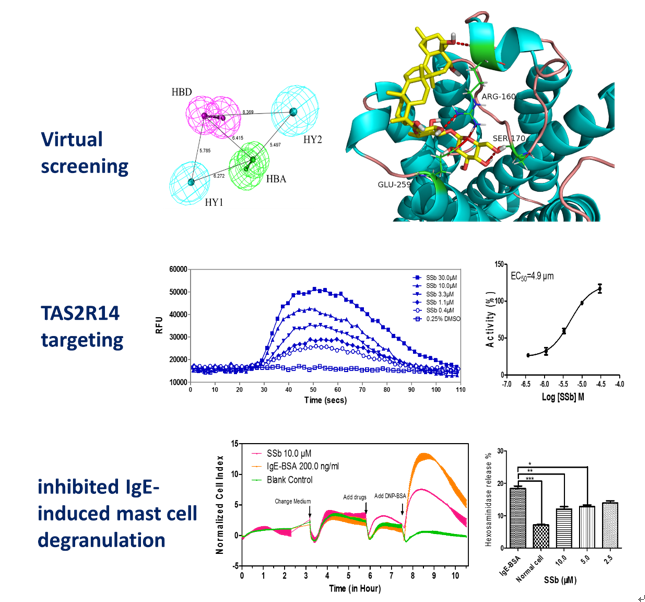Introduction
Human perception of bitter taste is mediated by taste type 2 receptors (TAS2Rs). Among these 25 subtype taste receptors, the expression and potential functional roles of TAS2R14 in airways have attracted a great deal of interests. TAS2R14 agonists, such as quinine, caffeine, diphenidol and noscapine, have been reported to induce significant effects on airway smooth muscle relaxation and inhibit IgE-dependent mast cell activation. TAS2R14 has great potential as a therapeutic target against respiratory diseases.
Methods
Ligand-based virtual screening was conducted on a library of chemicals contained in compositions of Radix Bupleuri, and these analyses were followed by cell-based functional validation through a HEK293-TAS2R14-G16gust44 cell line and IgE-induced mast cell degranulation assays, respectively.
Conclusion
Saikosaponin b (SSb) was confirmed for the first time to be a specific agonist of TAS2R14 and had an EC50 value of 4.9 μM. A molecular docking study showed that SSb could directly bind to a TAS2R14 model through H-bond interactions with Arg160, Ser170 and Glu259. Moreover, SSb showed the ability to inhibit IgE-induced mast cell degranulation, as measured with a β-hexosaminidase release model and real-time cell analysis (RTCA). Compared with prototypic bitter compounds for the 20 TAS2Rs deorphaned in a previous study, SSb is the first known TAS2R14 agonist with its particular chemical skeleton. Mast cells are important mediators of inflammatory responses such as allergy and anaphylaxis. SSb showed an inhibitory effect of mast cell degranulation, which could be proposed as a starting point for exploring whether it could show an anti-allergic asthma effect in animal models or clinic trials. In addition, the signal transduction mechanism deserves further study.
全文链接:https://www.nature.com/articles/s41598-017-11720-0.pdf

Fig. Identification of a specific agonist of human TAS2R14 from Radix Bupleuri through virtual screening, functional evaluation and binding studies